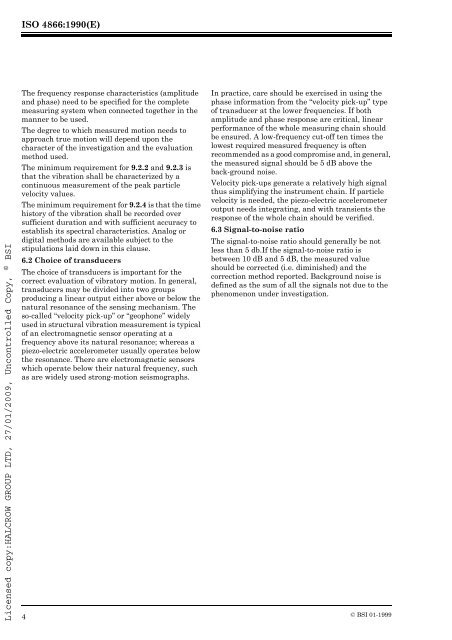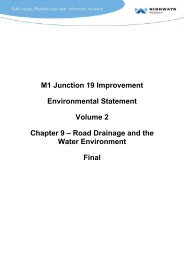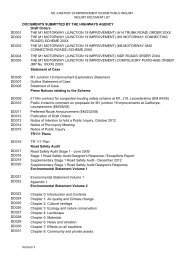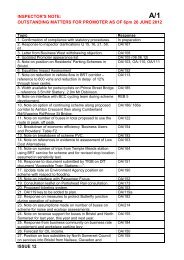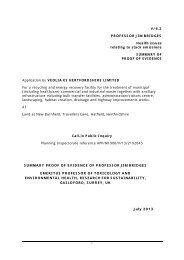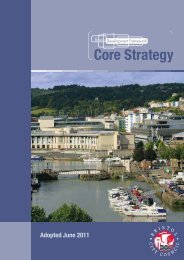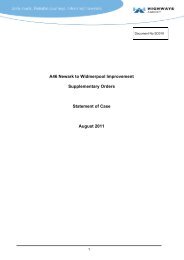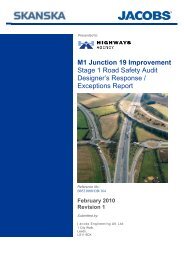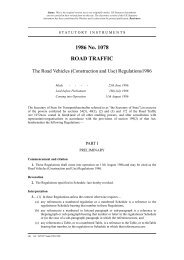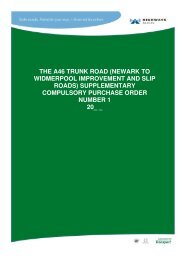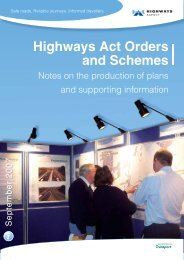Evaluation and Measurement for Vibration in Buildings Part 1, BSI ...
Evaluation and Measurement for Vibration in Buildings Part 1, BSI ...
Evaluation and Measurement for Vibration in Buildings Part 1, BSI ...
Create successful ePaper yourself
Turn your PDF publications into a flip-book with our unique Google optimized e-Paper software.
ISO 4866:1990(E)<br />
Licensed copy:HALCROW GROUP LTD, 27/01/2009, Uncontrolled Copy, © <strong>BSI</strong><br />
The frequency response characteristics (amplitude<br />
<strong>and</strong> phase) need to be specified <strong>for</strong> the complete<br />
measur<strong>in</strong>g system when connected together <strong>in</strong> the<br />
manner to be used.<br />
The degree to which measured motion needs to<br />
approach true motion will depend upon the<br />
character of the <strong>in</strong>vestigation <strong>and</strong> the evaluation<br />
method used.<br />
The m<strong>in</strong>imum requirement <strong>for</strong> 9.2.2 <strong>and</strong> 9.2.3 is<br />
that the vibration shall be characterized by a<br />
cont<strong>in</strong>uous measurement of the peak particle<br />
velocity values.<br />
The m<strong>in</strong>imum requirement <strong>for</strong> 9.2.4 is that the time<br />
history of the vibration shall be recorded over<br />
sufficient duration <strong>and</strong> with sufficient accuracy to<br />
establish its spectral characteristics. Analog or<br />
digital methods are available subject to the<br />
stipulations laid down <strong>in</strong> this clause.<br />
6.2 Choice of transducers<br />
The choice of transducers is important <strong>for</strong> the<br />
correct evaluation of vibratory motion. In general,<br />
transducers may be divided <strong>in</strong>to two groups<br />
produc<strong>in</strong>g a l<strong>in</strong>ear output either above or below the<br />
natural resonance of the sens<strong>in</strong>g mechanism. The<br />
so-called “velocity pick-up” or “geophone” widely<br />
used <strong>in</strong> structural vibration measurement is typical<br />
of an electromagnetic sensor operat<strong>in</strong>g at a<br />
frequency above its natural resonance; whereas a<br />
piezo-electric accelerometer usually operates below<br />
the resonance. There are electromagnetic sensors<br />
which operate below their natural frequency, such<br />
as are widely used strong-motion seismographs.<br />
In practice, care should be exercised <strong>in</strong> us<strong>in</strong>g the<br />
phase <strong>in</strong><strong>for</strong>mation from the “velocity pick-up” type<br />
of transducer at the lower frequencies. If both<br />
amplitude <strong>and</strong> phase response are critical, l<strong>in</strong>ear<br />
per<strong>for</strong>mance of the whole measur<strong>in</strong>g cha<strong>in</strong> should<br />
be ensured. A low-frequency cut-off ten times the<br />
lowest required measured frequency is often<br />
recommended as a good compromise <strong>and</strong>, <strong>in</strong> general,<br />
the measured signal should be 5dB above the<br />
back-ground noise.<br />
Velocity pick-ups generate a relatively high signal<br />
thus simplify<strong>in</strong>g the <strong>in</strong>strument cha<strong>in</strong>. If particle<br />
velocity is needed, the piezo-electric accelerometer<br />
output needs <strong>in</strong>tegrat<strong>in</strong>g, <strong>and</strong> with transients the<br />
response of the whole cha<strong>in</strong> should be verified.<br />
6.3 Signal-to-noise ratio<br />
The signal-to-noise ratio should generally be not<br />
less than 5db.If the signal-to-noise ratio is<br />
between 10 dB <strong>and</strong> 5dB, the measured value<br />
should be corrected (i.e. dim<strong>in</strong>ished) <strong>and</strong> the<br />
correction method reported. Background noise is<br />
def<strong>in</strong>ed as the sum of all the signals not due to the<br />
phenomenon under <strong>in</strong>vestigation.<br />
4<br />
© <strong>BSI</strong> 01-1999


